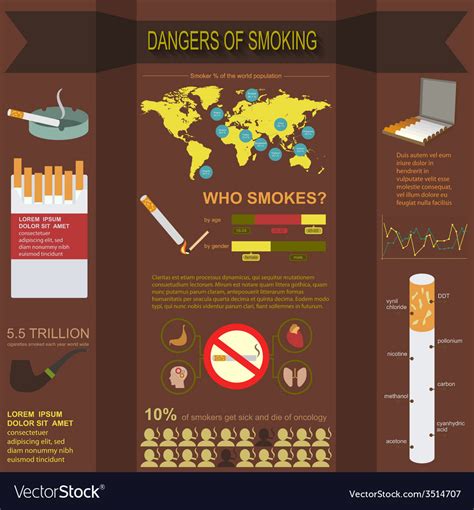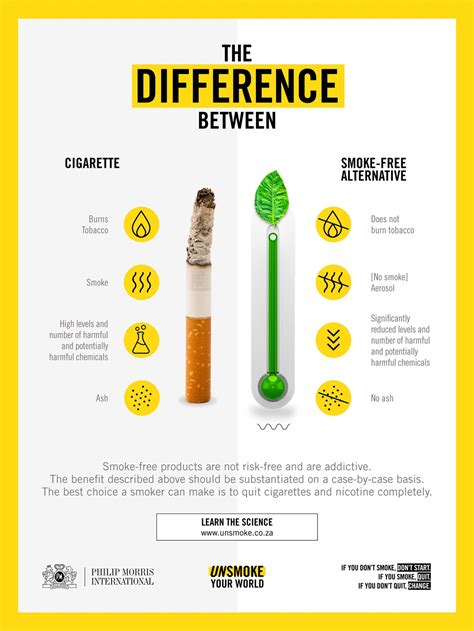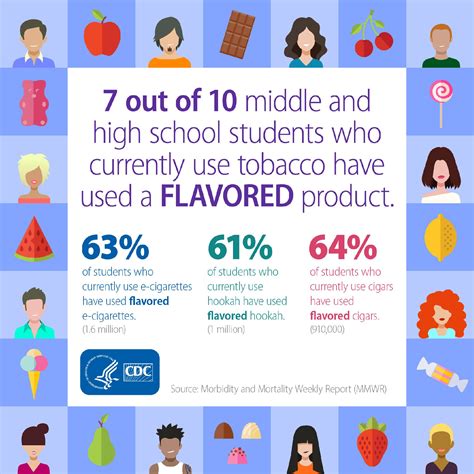In our quest for a brighter tomorrow, one vision emerges as a beacon of hope - a world where the dark cloud of tobacco no longer hangs over us. This vision transcends borders and cultures, igniting a collective desire for a healthier, cleaner, and more vibrant future.
In this promising realm, the oppressive grip of tobacco is replaced by the liberating embrace of fresh air and vitality. Beyond the reach of smoke-filled rooms and ashy residue, individuals breathe freely, unburdened by the chains of addiction. They are empowered to take charge of their well-being, to embrace a life thrumming with energy and vitality.
This vision is not just a fanciful flight of imagination; it is a tangible goal supported by the efforts of countless individuals and organizations. Through tireless advocacy and groundbreaking research, knowledge has blossomed and spread like wildfire, lighting the way towards a smoke-free horizon.
The Dangers of Smoking and the Urgency for a Smokeless Tomorrow

In today's society, the harmful consequences of tobacco consumption have become a pressing concern. It is crucial to acknowledge the detrimental effects that smoking has on individuals, communities, and the environment. Looking forward, there is an urgent need to transition towards a future free from the harmful effects of smoking.
Health Hazards: Smoking is a known catalyst for various life-threatening diseases, such as lung cancer, heart disease, and respiratory illnesses. Every puff of smoke inhaled contains harmful chemicals that damage the lungs and compromise overall well-being. Moreover, secondhand smoke poses a significant health risk to non-smokers, especially children and individuals with pre-existing conditions.
Socioeconomic Burden: Tobacco consumption remains a significant burden on society. The high healthcare costs associated with treating smoking-related diseases drain public resources and place a strain on healthcare systems. Additionally, lost productivity and increased absenteeism due to smoking-related illnesses contribute to significant economic losses.
Environmental Impact: Tobacco production, consumption, and disposal contribute to hazardous environmental consequences. The cultivation of tobacco plants requires vast amounts of land and water, leading to deforestation and water pollution. Moreover, the improper disposal of cigarette butts and packaging contributes to litter and toxic waste, further polluting the environment.
Call for Action: As the detrimental effects of smoking become increasingly evident, there is an urgent need to advocate for a smoke-free future. By raising awareness about the harmful health impacts, socioeconomic burdens, and environmental consequences of smoking, we can work towards implementing stricter regulations, providing support for cessation programs, and promoting healthier alternatives.
The path towards a smokeless society may seem challenging, but it is a necessary endeavor for the well-being of individuals, communities, and the planet as a whole. Together, we can build a future free from the detrimental effects of smoking, ensuring a healthier and sustainable tomorrow.
The Hazards Linked to Tobacco Use
Tobacco consumption has been connected to a multitude of detrimental effects on human health. The habit of lighting up and inhaling tobacco smoke can lead to several hazardous consequences that span physical, mental, and social dimensions.
Physical Health Risks
Smoking tobacco significantly heightens the risk of developing various life-threatening conditions such as lung cancer, chronic obstructive pulmonary disease (COPD), and cardiovascular diseases including heart attacks and strokes. Additionally, it can impair respiratory function, leading to breathing difficulties and decreased lung capacity. Tobacco use also contributes to accelerated aging, increased susceptibility to infections, and diminished overall physical stamina and endurance.
Mental Well-being Implications
The negative impact of smoking extends beyond physical health alone. Psychological studies have consistently shown a strong association between tobacco use and mental health disorders such as anxiety and depression. Nicotine addiction can exacerbate these conditions and hinder the effectiveness of treatment. Individuals who smoke may also experience more pronounced stress, reduced focus, and lower overall cognitive function compared to non-smokers.
Social Consequences
The repercussions of smoking extend beyond the individual, affecting the social fabric as well. Secondhand smoke, generated by individuals smoking in close proximity to others, poses a significant health risk to non-smokers, particularly children and individuals with respiratory conditions. Additionally, the financial burden of smoking on individuals, families, and society as a whole cannot be overlooked. Health care costs, productivity losses, and the environmental impact of tobacco cultivation and cigarette waste all contribute to the overall negative social consequences of smoking.
It is essential to comprehend the wide range of health risks and societal implications associated with smoking in order to provide informed perspectives on the pursuit of a smoke-free future. By raising awareness, implementing effective policies, and supporting smoking cessation efforts, steps can be taken towards achieving a healthier and tobacco-free society.
The Economic Impact of Smoking

As we strive towards a future free from the negative effects of smoking, it is crucial to consider the significant economic consequences associated with this harmful habit. The financial burden placed on individuals, communities, and nations due to smoking-related healthcare costs, decreased worker productivity, and lost economic opportunities cannot be underestimated.
| Economic Toll | |
|---|---|
| 1 | Healthcare Costs |
| The healthcare expenses linked to smoking-related illnesses place a heavy burden on individuals, families, and healthcare systems. These costs include not only the direct medical expenses for treatments but also indirect costs, such as lost productivity and premature mortality. | |
| 2 | Decreased Worker Productivity |
| Smoking negatively impacts workforce productivity in various ways. Smokers often experience more sick days, increased absenteeism, and reduced concentration levels compared to non-smokers. These factors, in turn, have a detrimental effect on overall economic output and the efficiency of businesses. | |
| 3 | Lost Economic Opportunities |
| The prevalence of smoking can limit economic development and hinder progress in various industries. Tobacco-related illnesses and premature deaths reduce the potential workforce, limit human capital accumulation, and lead to the loss of entrepreneurial and creative talents, all of which are vital for driving innovation and economic growth. |
The economic toll of smoking goes beyond individual expenditures and encompasses broader societal and global ramifications. By understanding and addressing these economic factors, we can better highlight the urgency of creating a smoke-free world and advocate for comprehensive tobacco control policies. Only by prioritizing the economic implications of smoking can we work towards a healthier, more prosperous future for all.
Advancing Towards a Tobacco-Free Tomorrow
In this section, we will explore the remarkable progress being made towards creating a healthier future by reducing the prevalence of smoking. By embracing innovative solutions and engaging in sustained efforts, societies around the world are moving steadily towards a future where tobacco use is a thing of the past.
Stepping into the Smoke-Free Era
The tobacco control movement has gained significant momentum in recent years, as governments, organizations, and individuals recognize the harmful effects of smoking on both personal health and public well-being. With an unwavering determination, they have set their sights on mitigating the harm caused by tobacco, aiming to bring about a world free from the shackles of addiction and its devastating consequences.
A Multifaceted Approach to Achieve Change
To achieve a smoke-free future, a multifaceted approach is being implemented, encompassing various strategies and interventions. These include widespread public awareness campaigns, stricter tobacco control policies, increased access to cessation resources, and the development of alternative nicotine delivery systems. By combining these approaches, individuals are empowered to make informed choices and communities are supported in their efforts to create tobacco-free environments.
An Evolving Landscape of Smoking Behavior
As a result of these concerted efforts, there has been a remarkable shift in smoking behavior worldwide. The prevalence of smoking has declined significantly, with a growing number of individuals choosing to quit or never start smoking. This changing landscape reflects a collective commitment towards a healthier future, where the detrimental impact of smoking is diminished, and the well-being of individuals and communities is nurtured.
Challenges and Future Perspectives
While progress has undoubtedly been made, challenges still lie ahead on the path towards a tobacco-free tomorrow. These challenges include overcoming the barriers to cessation, addressing the evolving landscape of tobacco products, and ensuring the sustainability of tobacco control efforts. However, with continued determination, collaboration, and innovation, the dream of a smoke-free future can become an attainable reality for generations to come.
In conclusion, the progress towards a smoke-free future is a testament to the unwavering commitment of societies worldwide to reduce the burden of tobacco use. Through comprehensive strategies and a changing landscape of smoking behavior, we move closer to a healthier, happier world, free from the harmful effects of smoking.
Exploring Alternatives to Achieve a Smoke-Free Lifestyle

In this section, we will explore various alternative solutions for individuals looking to break free from their smoking habits. We will delve into different approaches and strategies that can help individuals quit smoking and adopt a healthier lifestyle, without the use of traditional methods.
1. Nicotine Replacement Therapies:
- Nicotine patches
- Nicotine gum
- Nicotine nasal sprays
- Nicotine inhalers
- Nicotine lozenges
2. Behavioral Therapies:
- Cognitive-Behavioral Therapy (CBT)
- Motivational Interviewing
- Hypnotherapy
- Mindfulness-Based Stress Reduction (MBSR)
- Support groups and counseling
3. Alternative Therapies:
- Acupuncture
- Aromatherapy
- Herbal remedies
- Exercise and physical activity
- Meditation and relaxation techniques
4. Technology-Assisted Solutions:
- Mobile applications designed to quit smoking
- Fitness trackers and smartwatches to monitor progress
- Online programs and platforms offering support and guidance
- Virtual reality therapy
- Smartphone-based coaching and motivational tools
By exploring these alternative solutions, individuals can discover the most suitable approach to help them quit smoking and embrace a healthier lifestyle. Each person's journey is unique, and it is important to find the method that works best for them.
Legislation and Policies to Achieve a Tobacco-Free Tomorrow
One key aspect in realizing a future free from the detrimental effects of tobacco is the implementation of effective legislation and policies. Governments worldwide have recognized the urgent need to tackle the devastating consequences associated with smoking and have taken various measures to promote a tobacco-free society.
Through the introduction of comprehensive tobacco control laws, policymakers aim to limit the accessibility and appeal of tobacco products, as well as protect non-smokers from exposure to second-hand smoke. Such legislation focuses on various aspects, including restrictions on advertising and promotion, raising taxes on tobacco products, and implementing smoke-free policies in public spaces.
Advertising restrictions: Governments have sought to restrict the marketing and promotion of tobacco products by imposing stringent advertising regulations. These measures include prohibiting tobacco advertising in traditional media platforms, as well as limiting sponsorship and promotion of tobacco products at public events. By curbing the influence of tobacco advertisements, policymakers aim to reduce the allure of smoking and prevent the initiation of tobacco use, particularly among the younger population.
Taxation: Increasing the price of tobacco products through higher taxes has proven to be an effective strategy in discouraging smoking. Higher prices not only make cigarettes less affordable but also act as a deterrent, particularly for price-sensitive individuals, including young people and low-income populations. The additional revenue generated from increased taxes can be utilized to fund anti-smoking campaigns, healthcare initiatives, and support smoking cessation programs.
Smoke-free policies: Implementing smoke-free policies in public places, such as restaurants, bars, workplaces, and public transportation, is another crucial aspect of tobacco control legislation. By creating environments where smoking is not permitted, these policies protect non-smokers from the harmful effects of second-hand smoke, promote a culture of health and well-being, and further contribute to reducing the social acceptance of smoking.
International collaboration: Recognizing that tobacco-related issues transcend national boundaries, collaborative efforts among countries have also played a significant role in promoting a tobacco-free future. International agreements and frameworks, such as the World Health Organization's Framework Convention on Tobacco Control (FCTC), facilitate cooperation between nations, encourage policy exchange, and support the implementation of evidence-based practices to combat tobacco use and its consequences worldwide.
By enacting and enforcing such legislation and policies, governments can create an environment where smoking becomes less enticing and eventually eradicate this harmful habit, paving the way for a healthier and smoke-free tomorrow.
The Significance of Education and Awareness in Reducing Smoking Rates

Education and awareness play a pivotal role in combating the habit of smoking and achieving a society free from the harmful effects of tobacco. By promoting knowledge and understanding, individuals are equipped with the necessary tools to make informed decisions regarding their health and well-being.
1. Molding Minds: Providing education at an early age is key to preventing smoking initiation. Introducing comprehensive tobacco education programs in schools can empower young minds with accurate information about the hazards of smoking. It can also cultivate critical thinking and decision-making skills, enabling students to make choices that prioritize their long-term health.
- Empowering the Next Generation: By educating adolescents about the dangers of smoking, we empower them to resist peer pressure and make choices that align with their aspirations for a healthier life.
- Curbing the Myths: Dispelling misconceptions surrounding smoking through education helps individuals understand the true impact it has on their health and the health of those around them.
- Encouraging Smoke-Free Lifestyles: Education can highlight the benefits of adopting a smoke-free lifestyle, emphasizing the positive impacts on physical well-being, mental health, and overall quality of life.
2. Raising Awareness: Beyond formal education, creating widespread awareness about the dangers of smoking is crucial in reducing smoking rates.
- Media Campaigns: Through targeted media campaigns, organizations can utilize various platforms to reach a wide audience and deliver impactful anti-smoking messages. These campaigns can underscore the health risks, financial implications, and social consequences associated with smoking.
- Supportive Communities: Building communities that promote smoke-free environments and provide support for those trying to quit smoking can play a significant role in reducing smoking rates. This can be achieved through initiatives such as smoke-free public spaces, cessation programs, and support groups.
- Engaging Role Models: Utilizing influential personalities, such as celebrities and athletes, who have successfully quit smoking can inspire others to follow suit. Their stories can serve as powerful motivators for individuals to strive for a smoke-free life.
By placing education and awareness at the forefront, we can create a future where individuals possess the knowledge and determination to choose a smoke-free existence. Together, we can strive towards a healthier society and alleviate the burden of smoking-related diseases and premature deaths.
The Significance of Collaboration in Achieving a Tobacco-Free Vision
In order to transform the envisioned reality of a world free from the adverse effects of tobacco consumption, fostering collaboration among individuals, organizations, and governments becomes a paramount necessity. The realization of this collective dream heavily relies on the active involvement of various stakeholders working in synchrony towards the common goal of a healthier society.
Collaboration holds immense importance as it encourages the pooling of diverse perspectives, resources, and expertise to address the multifaceted challenges associated with tobacco use. Through collaborative initiatives, the potential for innovative solutions and comprehensive strategies to combat smoking is amplified, thereby paving the way for a smoke-free tomorrow.
The power of collaboration lies in its ability to bridge the gaps and overcome barriers that might hinder progress towards a tobacco-free future. By fostering partnerships, stakeholders from different sectors - including health professionals, policymakers, community leaders, and researchers - can leverage their unique skills and knowledge to develop effective interventions, implement evidence-based policies, and promote awareness about the detrimental consequences of smoking.
Collaborative efforts also facilitate the sharing of best practices and lessons learned, enabling stakeholders to build upon successful initiatives and avoid potential pitfalls. The pooling of resources, whether financial or intellectual, plays a vital role in supporting research and innovation aimed at understanding the complexities of tobacco addiction and devising strategies for prevention and cessation.
Furthermore, collaboration promotes synergy and collective ownership. When diverse entities unite under a shared vision, the momentum for change is augmented. By aligning goals, harmonizing efforts, and fostering a spirit of cooperation, the journey towards a tobacco-free society becomes more feasible, sustainable, and impactful.
In conclusion, collaboration acts as the driving force in realizing the vision of a world free from tobacco. By harnessing the strengths of various stakeholders, interdisciplinary cooperation, and knowledge exchange, we can collectively overcome the challenges posed by smoking and create an environment conducive to better health and well-being for all.
FAQ
What is the article "Dream of a Smoke-Free Future" about?
The article "Dream of a Smoke-Free Future" discusses the concept of a world without tobacco and the efforts being made to achieve a smoke-free future.
Why is it important to have a smoke-free future?
Having a smoke-free future is vital for several reasons. Firstly, it would greatly improve public health by reducing the number of people suffering from smoking-related diseases. Additionally, it would create a cleaner environment by eliminating second-hand smoke and cigarette litter. Lastly, it would contribute to reducing healthcare costs associated with smoking-related illnesses.
What are some initiatives or strategies mentioned in the article to achieve a smoke-free future?
The article mentions various initiatives and strategies in the quest for a smoke-free future. These include implementing stricter tobacco control policies, increasing public awareness about the dangers of smoking, promoting smoking cessation programs, and developing alternative nicotine products as less harmful alternatives to traditional cigarettes.



